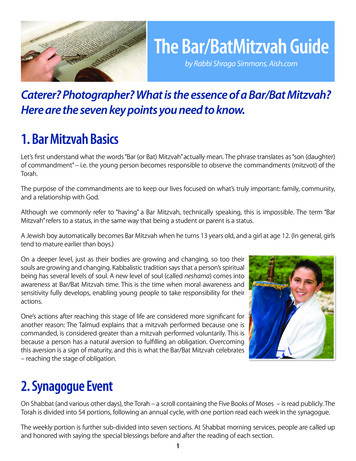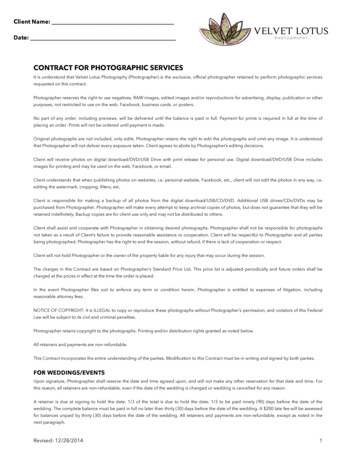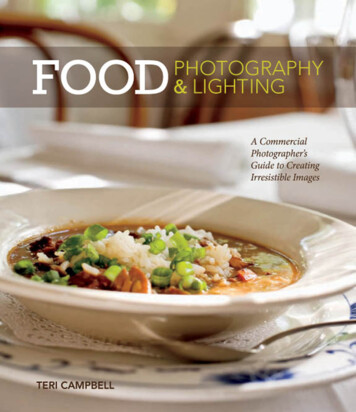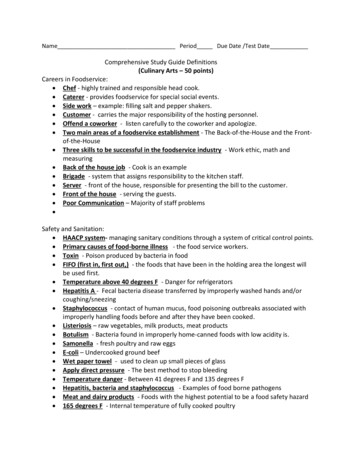
Transcription
The Bar/BatMitzvah Guideby Rabbi Shraga Simmons, Aish.comCaterer? Photographer? What is the essence of a Bar/Bat Mitzvah?Here are the seven key points you need to know.1. Bar Mitzvah BasicsLet’s first understand what the words “Bar (or Bat) Mitzvah” actually mean. The phrase translates as “son (daughter)of commandment” – i.e. the young person becomes responsible to observe the commandments (mitzvot) of theTorah.The purpose of the commandments are to keep our lives focused on what’s truly important: family, community,and a relationship with God.Although we commonly refer to “having” a Bar Mitzvah, technically speaking, this is impossible. The term “BarMitzvah” refers to a status, in the same way that being a student or parent is a status.A Jewish boy automatically becomes Bar Mitzvah when he turns 13 years old, and a girl at age 12. (In general, girlstend to mature earlier than boys.)On a deeper level, just as their bodies are growing and changing, so too theirsouls are growing and changing. Kabbalistic tradition says that a person’s spiritualbeing has several levels of soul. A new level of soul (called neshama) comes intoawareness at Bar/Bat Mitzvah time. This is the time when moral awareness andsensitivity fully develops, enabling young people to take responsibility for theiractions.One’s actions after reaching this stage of life are considered more significant foranother reason: The Talmud explains that a mitzvah performed because one iscommanded, is considered greater than a mitzvah performed voluntarily. This isbecause a person has a natural aversion to fulfilling an obligation. Overcomingthis aversion is a sign of maturity, and this is what the Bar/Bat Mitzvah celebrates– reaching the stage of obligation.2. Synagogue EventOn Shabbat (and various other days), the Torah – a scroll containing the Five Books of Moses – is read publicly. TheTorah is divided into 54 portions, following an annual cycle, with one portion read each week in the synagogue.The weekly portion is further sub-divided into seven sections. At Shabbat morning services, people are called upand honored with saying the special blessings before and after the reading of each section.1
The Torah is removed from the ark and then carried to the bima, the raised platform from where the Torah is read.While the Torah is being carried, everyone stands out of respect.Colloquially speaking, when people say, “I had a Bar Mitzvah,” it means that they had an aliyah to the Torah insynagogue. “Aliyah” means to “go up” to the bima.The Torah scroll is meticulously written by hand by a God-fearing scribe. A number of rules ensure that the Torah iswritten with perfect accuracy, thus maintaining the unbroken chain of tradition back to Mount Sinai.On the Shabbat following his 13th birthday, the young man is called up to the Torah. This calculation follows theJewish calendar. At the conclusion of his final blessing, some synagogues have the custom to good-naturedly peltthe young man with candies.At this point it is customary for the father to recite the following blessing:Following this, the bar mitzvah boy reads a portion from the biblical prophets, called the Haftorah. During a periodof persecution 2,000 years ago, Jews were forbidden from reading the Torah, so they instituted a reading from theprophets that corresponds to the theme of that week’s Torah portion. The Haftorah is read with a unique traditionalmelody.Following services, the congregation usually joins in a Kiddush, a small lunch that begins with a blessing over wine.3. The ReceptionOne popular feature of the Bar/Bat Mitzvah celebration is a reception. This should ideally be held on the day whichthe young man/woman becomes 13/12 years old. If necessary, the celebration may be postponed somewhat.There are different practices regarding what is done at a Bar Mitzvah celebration. It is proper for the young personto relate some Torah thoughts at the celebration – i.e. the famous Bar Mitzvah speech. The speech usually containsideas from the weekly Torah portion, and emphasizes the young person’s commitment to Jewish values.And what about that Titanic-themed party with Hollywood-style special effects? It’s important that the festivitiesshould not become so ostentatious that the spiritual significance becomes secondary. The new adult shouldappreciate that this is a celebration of maturity and responsibility, a message which will carry through for the restof their life.2
4. The GiftNow what about the ubiquitous Bar Mitzvah gift? In the old days, the gift of choice wasa fountain pen, then a Walkman, and today an iPod.Those are just fine but there are much more meaningful gifts for a Bar/Bat Mitzvah. Sincethis event celebrates the young person becoming obligated in the commandments,the most appropriate gift is, naturally, one that gives a deeper understanding of theJewish heritage and enables one to better perform the mitzvot! (An iPod, s/he can getanytime.)With that in mind, my favorite gift idea is a tzedakah (charity) box. Every Jew shouldhave a tzedakah box in his home, so he can drop in change on a regular basis. Themoney can then be given to support a Jewish school or institution -- in your hometown or in Israel (every Jews’ “home town”). There are beautiful tzedakah boxes madeof wood and silver, and you can see a selection at judaicawebstore.com.The next obvious gift is a Jewish book. There are many hundreds of titles to choose from, so I’ve narrowed it downto the Bar/Bat Mitzvah Top 10. To order, just click on the title or go to amazon.com.Stone Chumash (published by ArtScroll), an excellent translation of the Five Books of Moses with runningcommentary on every pageBook of our Heritage by Rabbi Eliyahu Kitov (Feldheim), a beautiful overview of the Jewish holidaysThe Bar Mitzvah Treasury, an illustrated collection of customs and inspiring stories (by Rabbi Yonah Weinrib andRabbi Yaakov Salomon; ArtScroll)The Thinking Teenagers Guide to Life by Rabbi Akiva Tatz (Targum), gripping essays on forging a path throughlifeSand and Stars by Yaffa Ganz (ArtScroll), a two-volume book about Jewish history, written especially forteenagersShmooze by Rabbi Nechemia Coopersmith, a fun book that provokesthoughtful discussions on essential Jewish issuesThe Long Road to Freedom, by Avner Gold, an exciting historical novelfilled with intrigue and insight into Jewish life.Bible for the Clueless But Curious by Rabbi Nachum Braverman(Leviathan), packed with wisdom on relationships, spirituality and moreCandles in my Window by Beth Firestone, a delightful fiction bookabout a young girl discovering her JudaismTriumph – Aish.com’s popular book of inspiring true stories of challengeand spiritual growth.If all else fails, you can always give money. It is a nice idea to give 18 (or some multiple thereof ), since the numericalvalue of 18 in Hebrew is “Chai,” which means “Life.”3
5. TefillinUpon reaching age 13, a boy begins the obligation to put on tefillin every day (except Shabbat and holidays).Tefillin are two square, black leather boxes, which contain parchments of Torah verses. Attached to each box areblack leather straps. One of the boxes is worn on the bicep, and the other is worn on the front of the head.The two boxes represent the two ways that we serve God in this world: thought (the head) and action (the arm).The arm-tefillin contains one parchment in one compartment, whereas the head-tefillin is four parchments, eachin its own separate compartment. This is to signify that in service of God, the two powers must work congruently:We use the totality of our mind to gain the full perspective, and then we act with a singular clarity of purpose.Inside each tefillin box are parchments containing four Torahsections, which speak about God’s unity, the obligation to observethe commandments, and the responsibility to transmit Judaism toour descendants.If you’re really feeling generous, tefillin is a wonderful gift for a BarMitzvah boy. Owning a pair of tefillin (and wearing them!) is animportant part of Jewish identity. But since they are expensive(about 400), not every Bar Mitzvah boy has a pair. To make sureyou get kosher tefillin, go to judaicawebstore.com.6. The First Bar MitzvahNow here’s a Jewish trivia question: Who was the first person to have a Bar Mitzvah?We could actually suggest three answers:1) Abraham – The first person to begin observing some of the mitzvot was “the first Jew,” Abraham. However, hewas older than age 13 when he started, so.2) Isaac was the first person who was “Jewish” upon reaching age 13. The Torah writes, “And Abraham made a greatparty on the day” (Genesis 21:8), which the Midrash explains was a celebration for Isaac becoming Bar Mitzvah.3) Mount Sinai – Only when the Torah was given at Mount Sinai did Jews became truly obligated to observe themitzvot. Therefore, the Sinai experience was actually a mass Bar/Bat Mitzvah of the entire Jewish people.7. The Journey ContinuesSome have the misconception that Jewish practice is confined to the synagogue, or to an occasional holidaycelebration at home. The truth is that Torah and mitzvot punctuate every moment of our lives: setting standardsfor business ethics, proper speech, honoring parents, what we eat, and even how to care for pets!We refer to these laws as Torat Chaim, literally “instructions for living.” Torah is the ultimate “owner’s manual” formaximizing our pleasure and potential in life.Torah is a basis for life’s most important questions: How can I live a meaningful life? How can I build successful relationships,4
deal honestly in business, and fulfill my personal potential? How can I really make adifference in the world?Torah study emphasizes building a rational basis of belief, to engage one’s mind,stimulate the intellect through questioning and debate, and thereby nourish thesoul. It does not endorse a leap of faith, all-or-nothing decisions, or disengagementfrom the world.The goal of any Jew is not only to study the Torah, but to become a “living Torah,”who embodies the lofty ideals of “love your neighbor,” “peace on earth,” “justice forall,” “universal education,” “all men are created equal,” “dignity of the individual,” and“the preciousness of life.” These concepts all originate from the Torah, and thesehave defined the moral makeup of humanity.In Jewish life, a Bar/Bat Mitzvah does not represent the culmination of one’s Jewish education, but rather a steppingstone to a more mature and profound relationship with Jewish learning.This is illustrated by the following idea: If even one letter is missing from a Torah scroll, it is rendered invalid.According to tradition, each Jew corresponds to one letter in the Torah. This teaches that each and every one of ushas an integral role to play in the future of the Jewish people.Bar/Bat Mitzvah means to become educated, and to strengthen one’s Jewish pride through knowledge andunderstanding. It means to grow Jewishly, one step at a time. It means standing up for Israel and respecting everyJew. It means taking responsibility for the world, using the Torah as our guide, because that is the mission of theJewish people. And most of all, it means to love being Jewish.Success in achieving these goals is what we wish for the Bar/Bat Mitzvah, and the beginning of that journey is whatwe celebrate on this joyous occasion.Mazel tov!For more inspiring articles visit5
The Torah is removed from the ark and then carried to the bima, the raised platform from where the Torah is read. While the Torah is being carried, everyone stands out of respect. Colloquially speaking, when people say, "I had a Bar Mitzvah," it means that they had an aliyah to the Torah in synagogue. "Aliyah" means to "go up" to .










